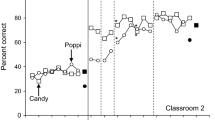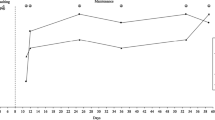Abstract
Discrete trial teaching (DTT) is a common instructional method incorporated into intensive behavioral intervention programs for children diagnosed with autism. Errorless learning strategies are frequently recommended during DTT because they often result in more efficient and effective instruction. The purpose of the present study was to conduct a sequential analysis of the efficacy of three methods for teaching errorless DTT procedures to novice instructors: (a) a self-instruction manual, (b) an instructional video, (c) and brief performance feedback. Three participants mastered DTT following self-instruction and the remaining three participants required all three interventions. The present study extends the literature on training DTT skills by (a) illustrating an efficient, sequential method of staff training, (b) introducing an improved self-instruction manual, and (c) clearly delineating guidelines for implementing an errorless prompt fading strategy during DTT.
Similar content being viewed by others
References
Arnal, L., Fazzio, D., Martin, G. L., Yu, C. T., Keilback, L., & Starke, M. (2007). Instructing university students to conduct discrete-trials teaching with confederates simulating children with autism. Developmental Disabilities Bulletin, 35, 131–147.
Batu, S., Ergenkon, Y., Erbas, D., & Akmanoglu, N. (2004). Teaching pedestrian skills to individuals with developmental disabilities. Journal of Behavioral Education, 13, 147–164.
Catania, C. N., Almeidia, D., Liu-Constant, B., & Digennaro Reed, F. D. (2009). Video modeling to train staff to implement discrete-trial instruction. Journal of Applied Behavior Analysis, 42, 387–392.
Crockett, J. L., Fleming, R. K., Doepke, K. J., & Stevens, J. S. (2007). Parent training: Acquisition and generalization of discrete trial teaching skills with parents of children with autism. Research in Developmental Disabilities, 28, 23–36.
Csapo, M. (1981). Comparison of two prompting procedures to increase response fluency among severely handicapped learners. The Journal of the Association for the Severely Handicapped, 6, 39–47.
Cuvo, A. J., Leaf, R. P., & Borakov, L. S. (1978). Teaching janitorial skills to the mentally retarded. Acquisition, generalization, and maintenance. Journal of Applied Behavior Analysis, 11, 325–355.
Day, H. M. (1987). Comparison of two prompting procedures to facilitate skill acquisition among severely mentally retarded adolescents. American Journal of Mental Deficiency, 91, 366–372.
Demchak, M. (1990). Response prompting and fading methods: A review. American Journal of Retardation, 94, 603–615.
Dib, N., & Sturmey, P. (2007). Reducing student stereotypy by improving teachers’ implementation of discrete-trial teaching. Journal of Applied Behavior Analysis, 40, 339–343.
DiGennaro Reed, F. D., Codding, R., Catania, C. N., & Maguire, H. (2010). Effects of video modeling on treatment integrity of behavioral interventions. Journal of Applied Behavior Analysis, 43, 291–295.
Downs, A., Downs, R. C., & Rau, K. (2008). Effects of training and feedback on discrete trial teaching skills and student performance. Research in Developmental Disabilities, 29, 235–246.
Fazzio, D., & Martin, G. L. (2006). Discrete-trials teaching with children with autism: A self-instructional manual. Unpublished manuscript.
Fazzio, D., & Martin, G. L. (2007). Discrete-trials teaching with children with autism: A self-instructional manual. Unpublished manuscript.
Fazzio, D., Martin, G. L., Arnal, L., & Yu, D. C. T. (2009). Instructing university students to conduct discrete-trials teaching with children with autism. Research in Autism Spectrum Disorders, 3, 57–66.
Frea, W. D., & McNerny, E. K. (2008). Early intensive applied behavior analysis intervention for autism. In J. K. Luiselli, D. C. Russon, W. P. Christian, & S. M. Wilczynski (Eds.), Effective practices for children with autism: Educational and behavioral support interventions that work (pp. 83–110). New York, NY: Oxford University Press.
Gentry, D., Day, M., & Nakao, C. (1979). The effectiveness of two prompting sequencing procedures for discrimination learning with severely handicapped individuals. Moscow: University of Idaho.
Gilligan, K. T., Luiselli, J. K., & Pace, G. M. (2007). Training paraprofessional staff to implement discrete trial instruction: Evaluation of a practical performance feedback intervention. the Behavior Therapist, 30, 63–69.
Iwata, B. A., Wallace, M. D., Kahng, S., Lindberg, J. S., Roscoe, E. M., Conners, J., et al. (2000). Skill acquisition in the implementation of functional analysis methodology. Journal of Applied Behavior Analysis, 33, 181–194.
Jacobson, J. W., & Mulick, J. A. (2000). System and cost research issues in treatments for people with autistic disorders. Journal of Autism and Developmental Disorders, 30, 585–593.
Jerome, J., Frantino, E. P., & Sturmey, P. (2007). The effects of errorless learning and backward chaining on the acquisition of internet skills in adults with developmental disabilities. Journal of Applied Behavior Analysis, 40, 185–189.
Kayser, J. E., Billingsley, F. F., & Neel, R. S. (1986). A comparison of in-context and traditional instructional approaches: Total task, single trial versus backward chaining, multiple trials. Journal of the Association for Persons with Severe Handicaps, 11, 28–38.
LeBlanc, M. P., Ricciardi, J. N., & Luiselli, J. K. (2005). Improving discrete trial instruction by paraprofessional staff through an abbreviated performance feedback intervention. Education and Treatment of Children, 28, 76–82.
Lefasakis, M., & Sturmey, P. (2007). Training parent implementation of discrete-trial teaching: Effects on generalization of parent teaching and child correct responding. Journal of Applied Behavior Analysis, 40, 685–689.
Love, J. R., Carr, J. E., Almason, S. M., & Petursdottir, A. I. (2009). Early and intensive behavioral intervention for autism: A survey of clinical practices. Research in Autism Spectrum Disorders, 3, 421–428.
Massey, N. G., & Wheeler, J. J. (2000). Acquisition and generalization of activity schedules and their effects on task engagement in a young child with autism in an inclusive preschool classroom. Education and training in Mental Retardation and Developmental Disabilities, 35, 326–335.
McDonnell, J., & Ferguson, B. (1989). A comparison of time delay and decreasing prompt hierarchy strategies in teaching banking skills to students with moderate handicaps. Journal of Applied Behavior Analysis, 22, 85–91.
Miller, U. C., & Test, D. W. (1989). A comparison of constant time delay and most-to-least prompting in teaching laundry skills to students with moderate retardation. Education and Training in Mental Retardation, 24, 363–370.
Miltenberger, R. G. (2008). Behavior modification: Principles and procedures (4th ed.). Pacific Grove, CA: Thomson/Wadsworth.
Mueller, M. M., Palkovic, C. M., & Maynard, C. S. (2007). Errorless learning: Review and practical application for teaching children with pervasive developmental disorders. Psychology in the Schools, 44, 691–700.
Ryan, C. S., & Hemmes, N. S. (2005). Post-training discrete-trial teaching performance by instructors of young children with autism in early intensive behavioral intervention. The Behavior Analyst Today, 6, 1–136.
Salem, S., Fazzio, D., Arnal, L., Fregeau, P., Thomson, K. M., Martin, G. L., & Yu, C. T. (2009). A self-instruction package for teaching university students to conduct discrete-trials teaching with children with autism. Journal on Developmental Disabilities, 15, 21–29.
Sarokoff, R. A., & Sturmey, P. (2004). The effects of behavioral skills training on staff implementation of discrete-trial teaching. Journal of Applied Behavior Analysis, 37, 535–538.
Sarokoff, R. A., & Sturmey, P. (2008). The effects of instructions, rehearsal, modeling, and feedback on acquisition and generalization of staff use of discrete trial teaching and student correct responses. Research in Autism Spectrum Disorders, 2, 125–136.
Smith, T. (2001). Discrete trial training in the treatment of autism. Focus on Autism and Other Developmental Disabilities, 16, 86–92.
Thiessen, C., Fazzio, D., Arnal, L., Martin, G. L., Yu, C. T., & Keilback, L. (2009). Evaluation of a self-instructional manual for conducting discrete-trials teaching with children with autism. Behavior Modification, 33, 360–373.
Thompson, K. M., Martin, G. L., Fazzio, D., Salem, S., Young, K., & Yu, C. T. (2012). Evaluation of a self-instruction package for teaching tutors to conduct discrete-trials teaching with children with autism. Research in Autism Spectrum Disorders, 6, 1073–1082.
Author information
Authors and Affiliations
Corresponding author
Additional information
This article is based on a dissertation submitted by the first author, under the supervision of the second author, in partial fulfillment of the requirements for the PhD degree in psychology at Western Michigan University. We thank Wayne Fuqua, Dick Malott, and John Austin for their helpful comments on the dissertation. This research was supported in part by Trinity Services, Inc. in Joliet, IL and Blue Cap in Blue Island, IL. The authors thank Art and Thane Dykstra, Nicole DeWitt, Jenifer Russell, Sharon Holcomb, Nancy Samardzic, James Lopresti, Ashley Siebert, Tony DiVittorio, and Laura Barnes for their assistance with and support of the research.
Rights and permissions
About this article
Cite this article
Severtson, J.M., Carr, J.E. Training Novice Instructors to Implement Errorless Discrete-Trial Teaching: A Sequential Analysis. Behav Analysis Practice 5, 13–23 (2012). https://doi.org/10.1007/BF03391820
Published:
Issue Date:
DOI: https://doi.org/10.1007/BF03391820




